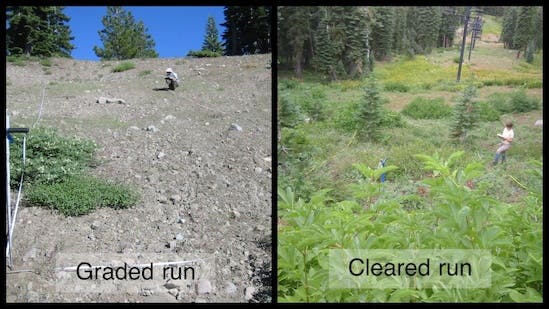Ski slopes (runs) are an environmental bane, as more and more studies are beginning to show. Even after 40 years of abandonment, the environment still fails to recover on the graded slopes.

Usually when a land is cleared of vegetation, the top soil remains mostly undisturbed, and tree, shrub and grass roots remain in the soil acting like a seed bank and accelerating recovery. But when a ski run is built, heavy machinery remove vegetation, boulders and, consequently, much of the topsoil and recovery mechanisms. A study published in December in the Journal of Applied Ecology evaluated six abandoned ski areas in the Northern Sierra region of California and Nevada and found that after almost half a century of abandonment, there is almost no sign of recovery. The study included the Lake Tahoe area sites of Powder Bowl, Plavada, Tannenbaum, Edelweiss, Iron Mountain and Echo Summit, who have been abandoned between 10 and 43 years ago.
“As more ski areas become abandoned, there should be some effort taken to actively restore graded ski slopes,” said lead author Jennifer Burt, a UC Davis doctoral student at the time of the study and currently a restoration ecologist at AECOM Environment in Sacramento. “These are large land areas in some cases and, as we’re seeing, they don’t recover on their own.”
As more and more runs are built and some are abandoned, it becomes more and more important to come up with a plan to regrow the vegetation and ensure that the slopes don’t end up barren moonscapes.
“We’re in this time of visible climate change,” said co-author Jeffrey Clary, reserve manager of Stebbins Cold Canyon Reserve in the UC Davis Natural Reserve System. “Land uses we once thought were permanent, we’re now seeing are likely not. As a land manager, to me, it only makes sense to look at a longer-term picture.”
The first thing to do, researchers say, is to destroy as much as possible when building the slope, but the biggest problem is grading. When a slope is built, it is first cleared, but then, it is graded to smooth the slope and remove bumps. It’s this that needs to be addressed – either don’t grade the slope at all, or at the very least, use lighter tools.
“If you’re going to create a new ski slope, ideally, you shouldn’t grade it,” Burt advised. “If grading is necessary, use a light touch and grade as little of the slope as possible so you don’t destroy the soil function for the long haul.”
Journal Reference: Jennifer W. Burt, and Jeffrey J. Clary – Initial disturbance intensity affects recovery rates and successional divergence on abandoned ski slopes. DOI: 10.1111/1365-2664.12584






